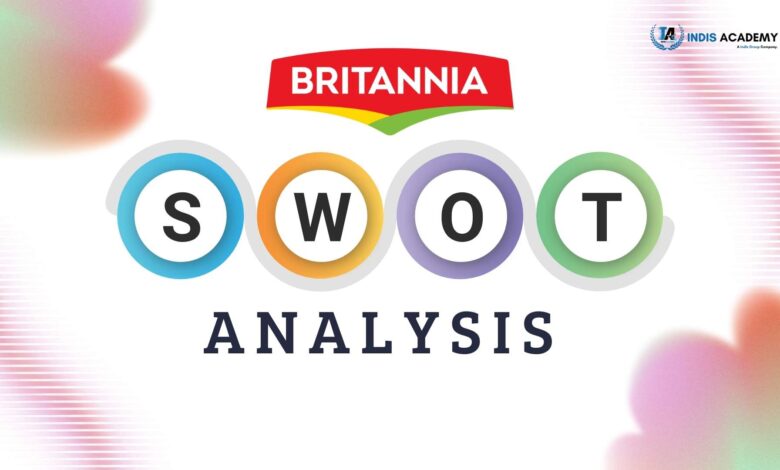SWOT Analysis of Britannia: How the Biscuit Giant Stays Ahead in India’s FMCG Market
Discover how Britannia dominates India’s FMCG sector with a strategic SWOT analysis highlighting its competitive strengths and market challenges.

When it comes to snacking in India, one name that instantly sparks recognition is Britannia. Whether it’s a pack of Good Day biscuits, Marie Gold with chai, or a slice of bread in your morning toast—Britannia has found a place in millions of Indian homes.
Over the years, it has grown from a bakery brand into one of India’s leading FMCG players, trusted across generations. But in a rapidly evolving market where consumer tastes are shifting and competition is rising, even established giants must adapt to stay ahead.
That’s where a SWOT analysis comes in.
In this blog, we’ll break down Britannia’s Strengths, Weaknesses, Opportunities, and Threats to understand how the company is positioned in 2025. Whether you’re a business student, investor, or simply curious about India’s most iconic food brands—this strategic overview is designed to keep you informed and engaged.
Let’s start with a quick look at the company itself before diving into the core analysis.
Also Read: Complete SWOT Analysis of Swiggy – India’s Leading Food Delivery Service
Learn AI & Digital Marketing,
Pay Fees After Placement
- ✅ Minimal Admission Fees
- ✅ No Loan or Income Sharing Agreement
- ✅ 100% Placement Support
- ✅ ISO & Govt Registered Certificate
- ✅ Practical 3+1 Months Duration
Get a free counseling call. We’ll guide you through learning, certification, and job placement.
Request a Free Call Back
Takes less than a minute.
Company Overview of Britannia Industries
Britannia Industries Limited, founded in 1892, is one of India’s oldest and most beloved food companies. Headquartered in Bengaluru, the company operates under the umbrella of the Wadia Group and has become a staple name in the Indian FMCG landscape.
From biscuits and bread to cakes, rusks, and dairy, Britannia offers a wide range of food products. Its flagship brands include:
- Good Day
- Marie Gold
- Tiger
- NutriChoice
- Milk Bikis
- Little Debbie (through partnership)
- And expanding dairy lines under Britannia Cheese and Milkman
As of 2025:
- Annual Revenue: ₹16,500+ crore
- Market Share in Biscuits: ~29% (second only to Parle)
- Distribution: Over 5 million retail outlets across India
- Export Presence: 70+ countries
Britannia has built its empire by combining affordability, taste, and trust—making it a force in both urban and rural markets.
What is a SWOT Analysis?
A SWOT analysis is a simple yet powerful tool used to assess a company’s internal and external position. It stands for:
- Strengths – What the company does well
- Weaknesses – Internal limitations or gaps
- Opportunities – External trends it can capitalize on
- Threats – Risks that could affect future growth
For a fast-moving consumer goods (FMCG) giant like Britannia, this analysis becomes essential. The Indian food market is evolving—consumers want healthier options, digital grocery platforms are rising, and global competition is heating up.
By evaluating Britannia’s SWOT, we can better understand its strategic position in 2025 and what it needs to do to stay at the top of India’s snack game.
Also Read: Complete SWOT Analysis of Patanjali – India’s Leading Ayurvedic Brand
Strengths of Britannia
Britannia’s growth story is built on trust, taste, and timely innovation. Over the decades, it has carved a space in Indian households that very few brands can rival. Let’s explore what makes Britannia one of the strongest FMCG players in the country:
1. Strong Brand Recognition Across India
From urban metros to remote villages, Britannia is a name that resonates with familiarity. Its massive recall value comes from decades of presence and a consistent brand message: “Eat Healthy, Think Better.”
This emotional connection gives Britannia an edge in both loyalty and shelf visibility.
2. Market Leader in Biscuits Segment
Britannia is the second-largest player in India’s ₹40,000+ crore biscuit industry, with nearly 29% market share—just behind Parle.
Flagship products like Good Day, Marie Gold, and NutriChoice cater to diverse customer segments, from indulgence to health-focused consumers.
3. Pan-India Distribution Network
With over 5 million retail outlets, Britannia’s distribution is wide and deep. It reaches rural markets better than most FMCG brands and is consistently expanding its presence through direct distribution and rural hubs.
4. Product Innovation and Category Diversification
Though known for biscuits, Britannia has successfully entered dairy, cakes, bread, rusk, and cheese segments.
It has also launched croissants, milkshakes, and flavored yogurts, tapping into modern urban snacking trends.
5. Efficient Pricing and Affordability Strategy
Britannia balances quality with price. Whether it’s a ₹5 pack for rural buyers or premium NutriChoice biscuits for the health-conscious urban user—it knows how to target price-sensitive and aspirational audiences alike.
Competitor Comparison Table
Let’s compare Britannia with its closest FMCG competitors in the snack and food category:
| Company | 2024 Revenue (INR Cr) | Key Segments | Market Share (Biscuits) | Global Presence |
|---|---|---|---|---|
| Britannia | ₹16,500+ | Biscuits, Dairy, Cakes, Bread | ~29% | 70+ countries |
| Parle Products | ₹17,000+ | Biscuits, Snacks, Confectionery | ~32% | 100+ countries |
| Nestlé India | ₹20,000+ | Dairy, Noodles, Chocolates | Small in Biscuits | 190+ countries |
| ITC Foods | ₹14,000+ | Snacks, Biscuits, Staples | ~10% | India-focused |
Note: Data is based on FY24-25 estimates and available public filings.
These strengths make Britannia not just a biscuit maker, but a serious FMCG powerhouse poised for future growth.
Also Read: The Future of Digital Marketing: How the Metaverse Is Redefining Customer Experience
Weaknesses of Britannia
While Britannia enjoys massive popularity and reach, there are certain internal limitations that could hinder its long-term growth. Recognizing these weaknesses helps understand where the brand may fall short or need strategic improvement.
1. Overdependence on Biscuit Segment
Despite its efforts to diversify, biscuits still contribute over 70% of Britannia’s total revenue. This lack of balance makes the company vulnerable to any shifts in biscuit consumption trends or raw material pricing shocks.
2. Limited Global Brand Visibility
Though Britannia exports to over 70 countries, it lacks the global brand appeal that competitors like Nestlé or even Parle (with its Gluco and Monaco biscuits) enjoy internationally.
This limits its potential to scale globally in the premium health snack or dairy categories.
3. Underdeveloped Dairy and Beverages Portfolio
Britannia’s presence in dairy is growing, but it’s still dwarfed by leaders like Amul in milk, cheese, and yogurt.
Moreover, the brand has little to no presence in fast-growing FMCG segments like ready-to-drink beverages, health drinks, and protein-based foods.
4. Weak Digital & D2C Ecosystem
While Britannia is available on major e-commerce platforms, its own digital or direct-to-consumer (D2C) presence is minimal.
In an era where online grocery shopping is booming, the lack of a strong digital ecosystem can limit visibility and consumer engagement.
5. Premium Product Perception in Rural Markets
Though widely distributed in rural India, certain Britannia products are perceived as premium or aspirational, limiting volume penetration when compared to more locally priced alternatives.
While none of these are deal-breakers, they signal the need for strategic focus and category rebalancing as Britannia looks ahead.
Opportunities for Britannia
India’s FMCG market is growing rapidly—and for a brand like Britannia, there are plenty of growth avenues waiting to be tapped. With the right investments and strategy, Britannia can evolve far beyond just biscuits.
Let’s look at the most promising opportunities:
1. Rising Demand for Healthy and Functional Snacks
Health-conscious consumers are actively seeking low-sugar, high-fiber, and protein-rich foods. Britannia can expand its NutriChoice and whole wheat product range, or even launch new sub-brands that cater specifically to wellness-driven snacking.
This is a fast-growing category, especially among millennials and working professionals.
2. High-Margin Dairy Expansion
India’s dairy market is projected to reach ₹25 lakh crore by 2030, and Britannia is just scratching the surface. With growing acceptance of cheese, flavored milk, and Greek yogurt, the brand has a real chance to challenge Amul and Nestlé in select niches.
Its recent investment in modern dairy plants shows the intent—but scaling product innovation and marketing is key.
3. Deeper Penetration into Rural Markets
As income levels rise in rural India, demand for packaged foods is increasing. Britannia already has a strong rural reach, but it can expand by offering smaller SKUs, regional flavors, and affordable snacking options.
Localized campaigns and last-mile delivery innovations can help double rural volumes over the next 3–5 years.
4. Export Potential to Indian Diaspora Markets
Britannia has strong emotional equity among Indians abroad. By scaling exports of traditional biscuits, cakes, and dairy, the brand can tap into the NRIs in the US, UK, UAE, and Australia who seek familiarity in food.
Tie-ups with ethnic grocery stores and e-commerce can boost this segment significantly.
5. Growth via Quick-Commerce & D2C Platforms
Platforms like Blinkit, Zepto, and Swiggy Instamart are booming. Britannia can strengthen its presence by launching exclusive packs, combo deals, or even limited-edition flavors for these platforms.
Also, creating its own D2C website or snack subscription model could build brand intimacy and unlock consumer data.
With the right mix of innovation, rural focus, and modern trade alignment, Britannia is well-positioned to expand both its top-line and consumer base in the coming years.
Also Read: 6 Proven Ways To Make $100/Day With Digital Marketing – Complete Guide
Threats to Britannia
While Britannia holds a strong position in the Indian FMCG space, it operates in a highly competitive and volatile environment. Several external threats could impact its growth, margins, and market leadership if not addressed in time.
Let’s break down the key risks:
1. Aggressive Competition from Parle, ITC & Regional Brands
Britannia faces constant pressure from players like Parle (which leads in volume), ITC’s Sunfeast, and local snack brands that offer similar products at lower prices.
Price wars, promotional battles, and shelf space competition can affect Britannia’s profitability—especially in mass-market segments.
2. Raw Material Inflation
Fluctuations in prices of wheat, sugar, milk, and packaging materials can heavily impact production costs. With margins already thin in FMCG, any supply chain disruption or inflation could hurt both pricing strategy and bottom lines.
3. Changing Consumer Preferences
As awareness around health, clean-label ingredients, and plant-based diets grows, traditional biscuits loaded with refined flour and sugar may lose favor—especially in urban markets.
If Britannia doesn’t quickly innovate, it risks falling behind health-focused startups and D2C brands.
4. Regulatory Scrutiny on Ingredients and Packaging
FSSAI and environmental bodies are tightening regulations around nutrition labeling, preservatives, and single-use plastic packaging. Britannia will need to invest in compliance, R&D, and sustainable materials to stay aligned.
5. Private Label Invasion by E-commerce Giants
Platforms like BigBasket, Amazon Pantry, and Reliance Smart are pushing their own snack brands—often priced lower with high visibility.
These private labels pose a silent but growing threat, especially for urban consumers looking for convenience and value.
These threats highlight the importance of speed, innovation, and agility in FMCG—qualities Britannia must continue to nurture in order to defend and grow its position.
Strategic Insights & Key Takeaways
Britannia’s journey from a humble bakery in Kolkata to becoming a dominant FMCG brand is a story of resilience and reinvention. But in 2025, it stands at a critical crossroads.
Here are the biggest takeaways from its SWOT analysis:
-
Strengths like deep brand trust, a vast distribution network, and biscuit leadership keep Britannia stable and profitable.
-
However, heavy reliance on a single product category (biscuits) exposes it to market risks and changing consumer preferences.
-
Its best growth opportunities lie in expanding dairy, health-focused snacks, and premium offerings, especially in tier-1 cities and global export markets.
-
Threats from inflation, regulations, and private labels can’t be ignored—Britannia must move faster to innovate and protect its shelf space.
If it aligns its traditional strengths with modern consumer needs and sustainability, Britannia is well-positioned to remain India’s snack-time favorite—while expanding far beyond it.
Conclusion
In a country where food is culture, Britannia has earned its place on millions of plates. With a legacy that spans over a century, it has grown into one of India’s most trusted and loved FMCG brands.
But as the market shifts—toward health, sustainability, and digital convenience—legacy alone won’t guarantee leadership. The SWOT analysis shows that while Britannia has a strong foundation, it needs to adapt rapidly to stay relevant in 2025 and beyond.
By investing in product innovation, deeper rural penetration, sustainable practices, and digital transformation, Britannia can secure its place not just in India’s kitchens, but also on the world stage.
FAQs – SWOT Analysis of Britannia
1. What is Britannia best known for?
Britannia is best known for its wide range of biscuits such as Good Day, Marie Gold, NutriChoice, and Milk Bikis. It also has a growing presence in dairy, cakes, and bread.
2. Who are Britannia’s main competitors?
Its main competitors in India are Parle Products, ITC (Sunfeast), Nestlé India, and regional/local snack brands. It also competes with private labels from online retailers.
3. What are the major threats to Britannia in 2025?
Major threats include raw material inflation, rising competition, regulatory challenges, and changing consumer preferences toward healthier and more sustainable products.
4. What are the growth opportunities for Britannia?
Britannia can grow by expanding into high-margin dairy products, functional health snacks, rural India, and export markets targeting the Indian diaspora.





